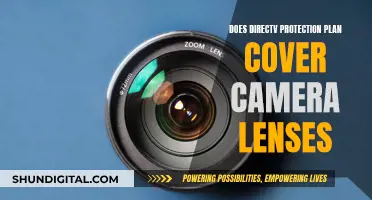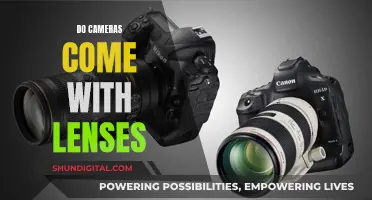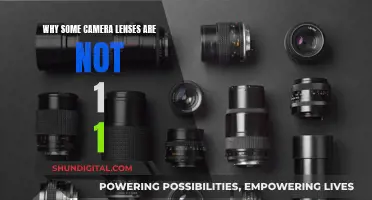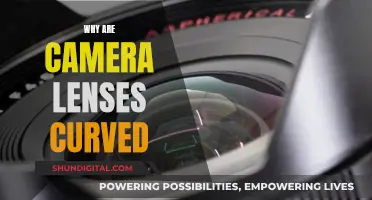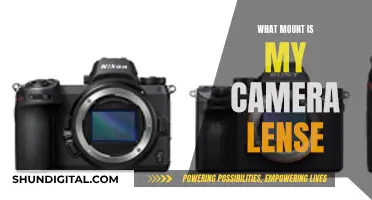
Camera lenses are not universally compatible with all cameras. The compatibility of a lens with a camera depends on the lens mount, which is the part of the camera where the lens clicks into place. Different camera brands often use different types of mounts, such as Canon's EF mount, Nikon's F mount, and Sony's E mount. The type of mount affects lens compatibility, so it is essential to ensure that the lens mount matches the camera device. While adapters can be used to connect different types of mounts, they may limit lens functions and affect the fit. Additionally, lenses from the same company that made the camera may not always work with the camera body due to differences in sensor size and other factors.
| Characteristics | Values |
|---|---|
| Compatibility of camera lenses | Depends on the lens mount |
| Lens mount | The junction where the camera and lens meet |
| Lens mount types | EF mount (Canon), F mount (Nikon), E mount (Sony), etc. |
| Interchangeability of lenses | Lenses are not completely interchangeable across brands and types of cameras |
| Adaptors | Allow lenses and cameras from different brands to work together |
| Limitations of adaptors | May limit lens functions, e.g. slower autofocus, manual adjustments |
| Third-party lenses | Sigma, Tamron, and Tokina are third-party lens manufacturers |
| Sensor size | Full-frame and APS-C are common sensor sizes |
| Lens options for different cameras | DSLR lenses, mirrorless camera lenses, compact system camera lenses |
What You'll Learn

Lens mounts and brands
The junction where your camera meets the lens is called the mount. Different brands often use different types of mounts. For example, Canon has its EF mount, Nikon has the F mount, and Sony uses the E mount. These mounts are like the unique 'language' each camera brand speaks, and they determine which lenses can directly fit onto your equipment.
Canon
Canon has a special kind of lens called an EF lens, which is made for its DSLR cameras (the ones with the mirror inside). All Canon DSLR cameras can use EF lenses, no matter how basic or advanced the camera is. Canon also makes mirrorless cameras (these don't have a mirror inside). These ones use RF lenses, which are different from EF lenses and are made just for mirrorless cameras. Canon also makes special adapters that let you use EF lenses on mirrorless devices.
Nikon
Nikon has two different lens mounts: F and Z. The former is for Nikon’s DSLR cameras, while the latter is for their newer mirrorless cameras.
Sony
Sony's A-mount is for DSLRs, while the E-mount is for mirrorless cameras.
Other Brands
Other camera brands with their own lens mounts include Leica (L-mount), Pentax (K-mount), and Fujifilm (X-mount and G-mount).
Third-Party Lens Makers
Third-party lens makers like Sigma, Tamron, and Tokina create lenses for a wide range of camera models. When buying a third-party lens, make sure it works for both your camera's mount and sensor size.
The Myth of Circular Camera Lenses: Fact or Fiction?
You may want to see also

Adapters and limitations
While camera lenses are not universal, adapters can be used to fit lenses from one brand onto a camera from another. However, this method has its limitations. Adapters act as translators, allowing lenses and cameras from different brands to work together. They fit between the camera and the lens, connecting different types of mounts.
The use of adapters can sometimes limit the functions of the lens. For example, the lens may not focus as quickly, or you may have to adjust settings manually. The fit may not be as secure as a lens that matches the camera's mount directly. Adapters can also be expensive, especially for those that work well.
Another factor to consider is the sensor size of the camera. Not every lens creates a large enough image circle to cover every sensor. Full-frame lenses will work on cameras with smaller sensors, but the image will appear zoomed-in compared to a full-frame camera. This is because the smaller sensor captures a smaller portion of the lens's image circle.
Additionally, different camera brands use different lens mounts, and even within the same brand, different camera models may have different mounts. For example, Canon has its EF mount, Nikon uses the F mount, and Sony uses the E mount. These mounts differ in size and shape, and the way they connect to the camera body. Therefore, it is important to ensure that the lens and camera are compatible by checking the lens mount and sensor size.
In summary, while adapters can provide a workaround to use lenses from different brands, there may be limitations in lens functionality. It is usually best to use lenses designed for your specific camera brand and model to ensure full compatibility and optimal performance.
Protect Your Camera Lens: Storage Tips for Photographers
You may want to see also

DSLR lenses vs. mirrorless camera lens mount
The DSLR vs mirrorless camera lens mount debate is an important one, especially with most manufacturers now focusing their efforts on mirrorless systems.
DSLR cameras use a mirror to reflect an optical image up into the viewfinder. When you take a picture, the mirror flips up, and the image is exposed to the sensor at the back of the camera. This means that the lens mount on a DSLR sits relatively far from the sensor.
Mirrorless cameras, on the other hand, use the camera sensor's 'live view' to produce an electronic image, displayed on the rear screen or in an electronic viewfinder. This means that the lens can sit much closer to the sensor.
It is very simple to adapt DSLR lenses to a mirrorless camera. Canon shooters, for instance, can use an adapter to put their older EF lenses (designed for DSLRs) onto R-series mirrorless bodies with almost no penalty in performance. However, it is difficult, and often impossible, to adapt native mirrorless lenses to a DSLR. The close proximity to the sensor of a mirrorless lens on a DSLR would seriously limit the range at which it could focus.
DSLRs have the advantage of decades of lens releases to choose from, but the development of new DSLR lenses has slowed dramatically. Canon and Nikon, for example, now put all their lens development effort into mirrorless lenses.
Mirrorless camera lenses, on the other hand, are rapidly catching up, and there is now a diverse range of lenses to suit almost every need. The options are constantly expanding, and it's only those with very niche requirements who are missing out by choosing mirrorless.
In summary, while DSLRs offer a wider selection of lenses, the gap is closing. Mirrorless lenses now rival DSLRs in terms of quality and performance, and the selection was much larger than it was a few years ago.
Understanding Camera Lens Interchangeability: What You Need to Know
You may want to see also

Sensor size and its effect on lens options
The sensor size of a camera is the physical size of its image sensor, usually measured in mm width x height. The most common sensor sizes are full-frame, APS-C, Micro Four Thirds, Super-35, DX, and 1-inch, among others. The sensor size affects the lens options available to the photographer, as not all lenses are compatible with all sensor sizes.
Full-frame sensors, such as those found in the Canon 5D, Sony a7S III, or the Sony Venice, measure roughly 36x24mm. Lenses designed for full-frame sensors will work on cameras with smaller sensors, but the image will appear zoomed-in or cropped. This is because the smaller sensor captures a smaller portion of the lens's image circle. For example, a 50mm lens with a full-frame image circle mounted on an APS-C lens will appear as a 75mm lens.
On the other hand, lenses designed for smaller sensors may not cover larger sensors. A lens designed for an APS-C sensor, for instance, will likely not cover a full-frame sensor. This is because the image circle projected by the lens needs to be large enough to cover the entire sensor.
Additionally, the sensor size affects the field of view. A particular lens will give a different field of view when used with cameras with different sensor sizes. For example, a 50mm lens on a full-frame camera will give a wider field of view than the same lens used on an APS-C camera.
The sensor size also impacts the depth of field. Smaller sensors offer a smaller depth of field compared to larger sensors when using the same aperture and focal length. This is because the smaller sensor size results in a further hyperfocal distance.
In summary, the sensor size of a camera affects the lens options available, the field of view, and the depth of field. Photographers need to consider the sensor size when choosing lenses to ensure compatibility and to understand how it will affect their images.
The High Cost of Camera Lenses: Why So Expensive?
You may want to see also

Third-party lens makers
One of the biggest advantages of third-party lenses is their affordability. They are often significantly cheaper than first-party lenses, making them a popular choice for photographers on a budget. This is partly due to lower advertising expenses and the use of less expensive materials. Additionally, third-party lenses provide more options, as they come with different mounts to fit various camera brands. For example, Sigma offers an 8mm fisheye lens, which is not available from Canon.
However, there are also some disadvantages to consider. Third-party lenses may have lower quality and durability standards, and they may not hold the same resale value as first-party lenses. It's important to research and compare different options before making a purchase.
Overall, third-party lenses can be a great option for photographers, especially those who are budget-conscious or seeking unique features. By offering a range of compatible lenses at competitive prices, third-party manufacturers provide photographers with more choices to suit their specific needs and enhance their craft.
Universal Camera Lenses: A Myth or Reality?
You may want to see also
Frequently asked questions
No, camera lenses are not universal. Each camera manufacturer uses different mounts, meaning a lens from one brand won't fit a camera from another without an adapter.
The junction where your camera meets the lens is called the mount. Every major company uses its own proprietary mount, so if you want to use a lens on a Canon camera, you'll need to buy a Canon lens or a third-party lens with the same mount.
Micro Four-Thirds lenses are an example of a standardised mount used by multiple manufacturers, including Panasonic, Olympus, and Black Magic. This means that lenses are interchangeable between these brands without the need for an adapter.
Yes, adapters allow you to use lenses from different brands on your camera. However, using an adapter may limit the functionality of the lens, such as slower autofocus or the need to adjust settings manually.
Yes, in addition to ensuring compatibility with your camera's mount, you should also consider the type of photography you want to do, your budget, and the specific features you require in a lens.


